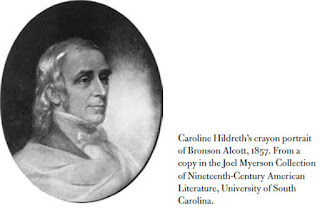Hands All Around: Alcotts at War
Block #1 by Addison
See a post on a star block for Abba here:
https://civilwarquilts.blogspot.com/2021/01/hands-all-around-1-hidden-nine-patch.html
A crayon portrait is drawn with what we might call chalk, a monochrome drawing done in a range of shades from black to white, often on a gray sheet of paper. The chalk is smudged to obtain various gradations. Shadows might be added with black and highlights finally with white. Brown chalks were also commonly used for monochrome pictures.Abba's dark eyes contrast with the highlights in her nose cheek and chin (the Alcott women had strong chins.) No artist is ever given credit for this portrait with its distinctive highlighting style including a few white squiggles on her lace collar.
The caption also tells us that the portrait was photographed from a picture belonging to Mrs. Bronson Alcott Pratt, probably Louise DeRevere Grant Pratt (1892-1984) wife of Bronson Alcott Pratt, Abba's great-grandson.
Abba's portrait is much in the same style as the portrait of her daughter Elizabeth Alcott (1835-1858). This is the only known picture of Elizabeth who died in her early 20s, so we know it was probably drawn before 1858. Again no artist is generally credited in the reproductions of the crayon drawing, in the collection of Orchard House.
A crayon portrait is drawn with what we might call chalk, a monochrome drawing done in a range of shades from black to white, often on a gray sheet of paper. The chalk is smudged to obtain various gradations. Shadows might be added with black and highlights finally with white. Brown chalks were also commonly used for monochrome pictures.Abba's dark eyes contrast with the highlights in her nose cheek and chin (the Alcott women had strong chins.) No artist is ever given credit for this portrait with its distinctive highlighting style including a few white squiggles on her lace collar.
The caption also tells us that the portrait was photographed from a picture belonging to Mrs. Bronson Alcott Pratt, probably Louise DeRevere Grant Pratt (1892-1984) wife of Bronson Alcott Pratt, Abba's great-grandson.
And here it is over the piano. It looks to be shades of reddish
brown chalk on brown paper.
As an artist myself (not a very good one) I'd have been fussy about this portrait if it were mine and would have asked the artist to take that shine off my nose. She probably would not have agreed to my request as the shiny nose is a style she affected often. You notice I say "she." I think I recognize that style.
I find at the last minute that Daniel Shealy's Annotated Edition of Little Women tells us what I'd guessed.
Portrait of Asiel Abercrombie by Caroline Negus Hildreth (1814-1867)
Collection of the University of Massachusetts Amherst
From Daniel Shealy's Alcott in Her Own Time
Abba critiqued the portrait:
"A tinge of the incomprehensible lies softly around it, a field of atmosphere as if she had worked with down from an angel's wing rather than with a crayon as if the moonlight had cast a shadow on the lights."
She was not pleased with the "mantle draped about the shoulders," not in keeping with Bronson's "neat and poor" appearance. About her own portrait we find no comment. And no one but me complains about the shiny noses.
Miniatures by Caroline Negus Hildreth from a Skinner Auction
Miniature on ivory of Ralph Waldo Emerson 1844
by Caroline
Probably this unaccredited double portrait, which may be in the
collection of the Concord Library.
Based on the visual similarities I would credit Elizabeth and Abigail Alcott's portraits to Caroline Negus Hildreth, probably done in the mid 1850s before Elizabeth became so ill she could not leave her bed in late 1857.
The Alcotts moved often in the mid 1850s, spending time in Boston, Concord and other places, trying to live as cheaply as possible, earn a little money and see to the education of their youngest daughter May who took art classes in Boston. Bronson Alcott mentions Mrs. Hildreth living in rooms on Tremont Row in a letter. The 1855 city directory lists her as an artist at 228 Washington Street.
Tremont Row in 1845
Richard Hildreth (1807-1865)
This may be a published reproduction of a chalk portrait by Caroline.
Caroline Negus married Richard Hildreth in 1844. Like Abba Alcott she financially supported a rather visionary husband. Richard spent the years in Boston working on a multi-volume history of the United States while she taught and drew portraits. In 1861 Massachusetts Senator Charles Sumner successfully lobbied the new Lincoln administration to appoint Richard Hildreth the consul at Trieste in Italy.
December, 1867 notice of Caroline's death, widely published
Richard and Caroline Hildreth died in Italy in the 1860s. I can find no pictures of Caroline herself.
Read more about the artist:
Mary Fuller, "Caroline Negus-A Woman Deerfield Should Remember," History and Proceedings of the Pocumtuck Valley Memorial Association 1921.

















I'm always amazed by your sleuthing skills. And such interesting people. Little Women is one of my all time favorite books. Thanks for sharing.
ReplyDeleteFascinating stuff. I have read some histories of Louisa and her family, including a biography of her father. I find all of your research so interesting. Thanks!
ReplyDeleteYou always make history fascinating and humorous. Shiny noses!
ReplyDeleteWhen my Dad was alive, born 1919, died 2009, he had a portrait of his mother on the living room wall that was one of those "crayon drawings". It was a good sized thing, well framed, and I took a good photograph of it. I believe the shiny nose is to help us have perspective by the light shining on things making the picture more interesting.
ReplyDelete